The Synergic Characteristics of Surface Water Pollution and Sediment Pollution with Heavy Metals in the Haihe River Basin, Northern China
Abstract
:1. Introduction
2. Materials and Methods
2.1. The Study Area
2.2. Sampling
2.3. Quantification of Surface Water Quality and Heavy Metals in Sediment
2.4. Assessment on Surface Water Quality
2.5. Potential Ecological Risk Index
2.6. Enrichment Factors
2.7. Data Analysis
3. Results
3.1. Surface Water Quality
3.2. Heavy Metals in Sediments
3.3. Synergic Pollution Characteristics in the Haihe River Basin
4. Discussion
4.1. The Driving Force Foreutrophication in the Haihe River Basin
4.2. The Effects of Industry Structure on Heavy Metal Pollution
4.3. The Effects of Human Activities on Synergic Pollution of Surface Water and Sediments
5. Conclusions
Acknowledgments
Author Contributions
Conflicts of Interest
References
- Gooddy, D.C.; Lapworth, D.J.; Bennett, S.A.; Heaton, T.H.E.; Williams, P.J.; Surridge, B.W.J. A multi-stable isotope framework to understand eutrophication in aquatic ecosystems. Water Res. 2016, 88, 623–633. [Google Scholar] [CrossRef] [PubMed] [Green Version]
- Zhang, H.; Lin, C.; Lei, P.; Shan, B. Evaluation of river eutrophication of the Haihe River Basin. Acta Sci. Circumst. 2015, 35, 2336–2344. (In Chinese) [Google Scholar]
- Zhang, R.; Zhou, L.; Zhang, F.; Ding, Y.; Gao, J.; Chen, J.; Yan, H.; Shao, W. Heavy metal pollution and assessment in the tidal flat sediments of Haizhou Bay, China. Mar. Pollut. Bull. 2013, 74, 403–412. [Google Scholar] [CrossRef] [PubMed]
- Tekile, A.; Kim, I.; Kim, J. Mini-review on river eutrophication and bottom improvement techniques, with special emphasis on the Nakdong River. J. Environ. Sci. 2015, 30, 113–121. [Google Scholar] [CrossRef] [PubMed]
- Smith, V.H.; Tilman, G.D.; Nekola, J.C. Eutrophication: Impacts of excess nutrient inputs on freshwater, marine, and terrestrial ecosystems. Environ. Pollut. 1999, 100, 179–196. [Google Scholar] [CrossRef]
- Lijklema, L. Development and eutrophication: Experiences and perspectives. Water Sci. Technol. 1995, 31, 11–15. [Google Scholar]
- Strokal, M.; Yang, H.; Zhang, Y.; Kroeze, C.; Li, L.; Luan, S.; Wang, H.; Yang, S.; Zhan, Y. Increasing eutrophication in the coastal seas of China from 1970 to 2050. Mar. Pollut. Bull. 2014, 85, 123–140. [Google Scholar] [CrossRef] [PubMed]
- Herbeck, L.S.; Unger, D.; Wu, Y.; Jennerjahn, T.C. Effluent, nutrient and organic matter export from shrimp and fish ponds causing eutrophication in coastal and back-reef waters of NE Hainan, tropical China. Cont. Shelf Res. 2013, 57, 92–104. [Google Scholar] [CrossRef]
- Zhang, C.; Yu, Z.-G.; Zeng, G.-M.; Jiang, M.; Yang, Z.-Z.; Cui, F.; Zhu, M.-Y.; Shen, L.-Q.; Hu, L. Effects of sediment geochemical properties on heavy metal bioavailability. Environ. Int. 2014, 73, 270–281. [Google Scholar] [CrossRef] [PubMed]
- Yi, Y.; Yang, Z.; Zhang, S. Ecological risk assessment of heavy metals in sediment and human health risk assessment of heavy metals in fishes in the middle and lower reaches of the Yangtze River basin. Environ. Pollut. 2011, 159, 2575–2585. [Google Scholar] [CrossRef] [PubMed]
- Peng, J.-F.; Song, Y.-H.; Yuan, P.; Cui, X.-Y.; Qiu, G.-L. The remediation of heavy metals contaminated sediment. J. Hazard. Mater. 2009, 161, 633–640. [Google Scholar] [CrossRef] [PubMed]
- Gao, X.; Chen, C.-T.A. Heavy metal pollution status in surface sediments of the coastal Bohai Bay. Water Res. 2012, 46, 1901–1911. [Google Scholar] [CrossRef] [PubMed]
- Christophoridis, C.; Dedepsidis, D.; Fytianos, K. Occurrence and distribution of selected heavy metals in the surface sediments of Thermaikos Gulf, N. Greece. Assessment using pollution indicators. J. Hazard. Mater. 2009, 168, 1082–1091. [Google Scholar] [CrossRef] [PubMed]
- Vega, M.; Pardo, R.; Barrado, E.; Debán, L. Assessment of seasonal and polluting effects on the quality of river water by exploratory data analysis. Water Res. 1998, 32, 3581–3592. [Google Scholar] [CrossRef]
- Zheng, M.; Zheng, H.; Wu, Y.; Xiao, Y.; Du, Y.; Xu, W.; Lu, F.; Wang, X.; Ouyang, Z. Changes in nitrogen budget and potential risk to the environment over 20 years (1990–2010) in the agroecosystems of the Haihe Basin, China. J. Environ. Sci. 2015, 28, 195–202. [Google Scholar] [CrossRef] [PubMed]
- Wang, Z.-G.; Luo, Y.-Z.; Zhang, M.-H.; Xia, J. Quantitative Evaluation of Sustainable Development and Eco-Environmental Carrying Capacity in Water-Deficient Regions: A Case Study in the Haihe River Basin, China. J. Integr. Agric. 2014, 13, 195–206. [Google Scholar] [CrossRef]
- Liu, X.; Li, G.; Liu, Z.; Guo, W.; Gao, N. Water Pollution Characteristics and Assessment of Lower Reaches in Haihe River Basin. Procedia Environ. Sci. 2010, 2, 199–206. [Google Scholar] [CrossRef]
- Yang, B.; Zhiyun, O.; Hua, Z.; Weihua, X.; Cheng, Z.; Changwei, Z.; Shuai, C.; Bo, J. Ecosystems patterns and dynamics in Haihe river basin. Acta Ecol. Sin. 2010, 30, 327–334. [Google Scholar] [CrossRef]
- Yang, T.; Liu, J.; Chen, Q. Evaluation of Environmental Flow Requirement for Improvement of River Ecological Integrity in the Haihe River Basin, China. Fresenius Environ. Bull. 2014, 23, 1121–1130. [Google Scholar]
- Qin, C.; Jia, Y.; Su, Z.; Bressers, H.T.A.; Wang, H. An Analysis of Water Consumption and Pollution with the Input-Output Model in the Haihe River Basin, China. Environ. Eng. 2014, 864–867, 1059–1069. [Google Scholar] [CrossRef]
- Wu, M.; Huang, S.; Wen, W.; Sun, X.; Tang, X.; Scholz, M. Nutrient distribution within and release from the contaminated sediment of Haihe River. J. Environ. Sci. 2011, 23, 1086–1094. [Google Scholar] [CrossRef]
- Tang, W.; Zhao, Y.; Wang, C.; Shan, B.; Cui, J. Heavy metal contamination of overlying waters and bed sediments of Haihe Basin in China. Ecotoxicol. Environ. Saf. 2013, 98, 317–323. [Google Scholar] [CrossRef] [PubMed]
- Liu, J.; Luan, Y.; Su, L.; Cao, Z.; Zeng, B. Public participation in water resources management of Haihe river basin, China: The analysis and evaluation of status quo. Procedia Environ. Sci. 2010, 2, 1750–1758. [Google Scholar]
- Li, Z.; Wang, J.; Guo, C. A universal index formula for eutrophic evaluation using a logarithmic power function. Acta Sci. Circumst. 2010, 30, 664–672. (In Chinese) [Google Scholar]
- Li, R.; Li, R.; Chai, M.; Shen, X.; Xu, H.; Qiu, G. Heavy metal contamination and ecological risk in Futian mangrove forest sediment in Shenzhen Bay, South China. Mar. Pollut. Bull. 2015, 101, 448–456. [Google Scholar] [CrossRef] [PubMed]
- Hakanson, L. An ecological risk index for aquatic pollution control. A sedimentological approach. Water Res. 1980, 14, 975–1001. [Google Scholar] [CrossRef]
- Feng, H.; Han, X.F.; Zhang, W.G.; Yu, L.Z. A preliminary study of heavy metal contamination in Yangtze River intertidal zone due to urbanization. Mar. Pollut. Bull. 2004, 49, 910–915. [Google Scholar] [CrossRef] [PubMed]
- Ghrefat, H.; Yusuf, N. Assessing Mn, Fe, Cu, Zn, and Cd pollution in bottom sediments of Wadi Al-Arab Dam, Jordan. Chemosphere 2006, 65, 2114–2121. [Google Scholar] [CrossRef] [PubMed]
- Zhang, J.; Liu, C.L. Riverine Composition and Estuarine Geochemistry of Particulate Metals in China—Weathering Features, Anthropogenic Impact and Chemical Fluxes. Estuar. Coast. Shelf Sci. 2002, 54, 1051–1070. [Google Scholar] [CrossRef]
- Han, Y.; Du, P.; Cao, J.; Posmentier, E.S. Multivariate analysis of heavy metal contamination in urban dusts of Xi’an, Central China. Sci. Total Environ. 2006, 355, 176–186. [Google Scholar]
- Wang, L.; Liu, L.; Zheng, B. Eutrophication development and its key regulating factors in a water-supply reservoir in North China. J. Environ. Sci. 2013, 25, 962–970. [Google Scholar] [CrossRef]
- Li, F.; Sun, H.; Hao, Z.; He, N.; Zhao, L.; Zhang, T.; Sun, T. Perfluorinated compounds in Haihe River and Dagu Drainage Canal in Tianjin, China. Chemosphere 2011, 84, 265–271. [Google Scholar] [CrossRef] [PubMed]
- State Environmental Protection Administration. Background Values of Soil Elements in China; China Environmental Science Press: Brighton, UK, 1990.
- Chai, M.; Shi, F.; Li, R.; Shen, X. Heavy metal contamination and ecological risk in Spartina alterniflora marsh in intertidal sediments of Bohai Bay, China. Mar. Pollut. Bull. 2014, 84, 115–124. [Google Scholar] [CrossRef] [PubMed]
- Bastami, K.D.; Bagheri, H.; Kheirabadi, V.; Zaferani, G.G.; Teymori, M.B.; Hamzehpoor, A.; Soltani, F.; Haghparast, S.; Harami, S.R.M.; Ghorghani, N.F.; et al. Distribution and ecological risk assessment of heavy metals in surface sediments along southeast coast of the Caspian Sea. Mar. Pollut. Bull. 2014, 81, 262–267. [Google Scholar] [CrossRef] [PubMed]
- Hamdoun, H.; Van-Veen, E.; Basset, B.; Lemoine, M.; Coggan, J.; Leleyter, L.; Baraud, F. Characterization of harbor sediments from the English Channel: Assessment of heavy metal enrichment, biological effect and mobility. Mar. Pollut. Bull. 2015, 90, 273–280. [Google Scholar] [CrossRef] [PubMed]
- Wang, X.; Zou, Z.; Zou, H. Water quality evaluation of Haihe River with fuzzy similarity measure methods. J. Environ. Sci. 2013, 25, 2041–2046. [Google Scholar] [CrossRef]
- Yin, L.; Ling, J. The Research of the Distribution of Phosphorus Content in Major Rivers in Tianjin. J. Anhui Agric. 2011, 36, 14764–14765. (In Chinese) [Google Scholar]
- Zhao, X.; Shan, B.; Zhang, W. Forms and Spatial Distribution Characteristics of Nitrogen in Ziya River Basin. Environ. Sci. 2014, 35, 143–149. (In Chinese) [Google Scholar]
- Zhao, Y.; Shan, B.; Tang, W.; Zhang, H. Nitrogen mineralization and geochemical characteristics of amino acids in surface sediments of a typical polluted area in the Haihe River Basin, China. Environ. Sci. Pollut. Res. 2015, 22, 17975–17986. [Google Scholar] [CrossRef] [PubMed]
- Smith, V.H. Eutrophication A2—Likens, Gene E. In Encyclopedia of Inland Waters; Academic Press: Oxford, UK, 2009; pp. 61–73. [Google Scholar]
- Tang, W.; Zhang, H.; Shan, B.; Li, S. Accumulation and risk assessment of sedimentary trace metals in response to industrialization from the tributaries of Fuyang River System. Environ. Earth Sci. 2015, 73, 1975–1982. [Google Scholar] [CrossRef]
- Tang, W.; Wang, L.; Shan, B.; Zhao, Y. Heavy metal pollution of the surface sediments in Daqing River System, Haihe Basin. Acta Sci. Circumst. 2015, 35, 3620–3627. (In Chinese) [Google Scholar]
- Wang, R.; Cheng, X.; Sun, R. Ecological Risk Assesment of Heavy Metals in Surface Sediments in the Southern and Central Haihe River Basin. Environ. Sci. 2014, 35, 3740–3747. (In Chinese) [Google Scholar]
- Hao, H.; Zhou, H.; Wang, J.; Li, G. Assessment on potential ecological risk due to heavy metals pollution in sediment in the South Zhangwei Canal. J. China Inst. Water Resour. Hydropower Res. 2005, 3, 109–115. (In Chinese) [Google Scholar]
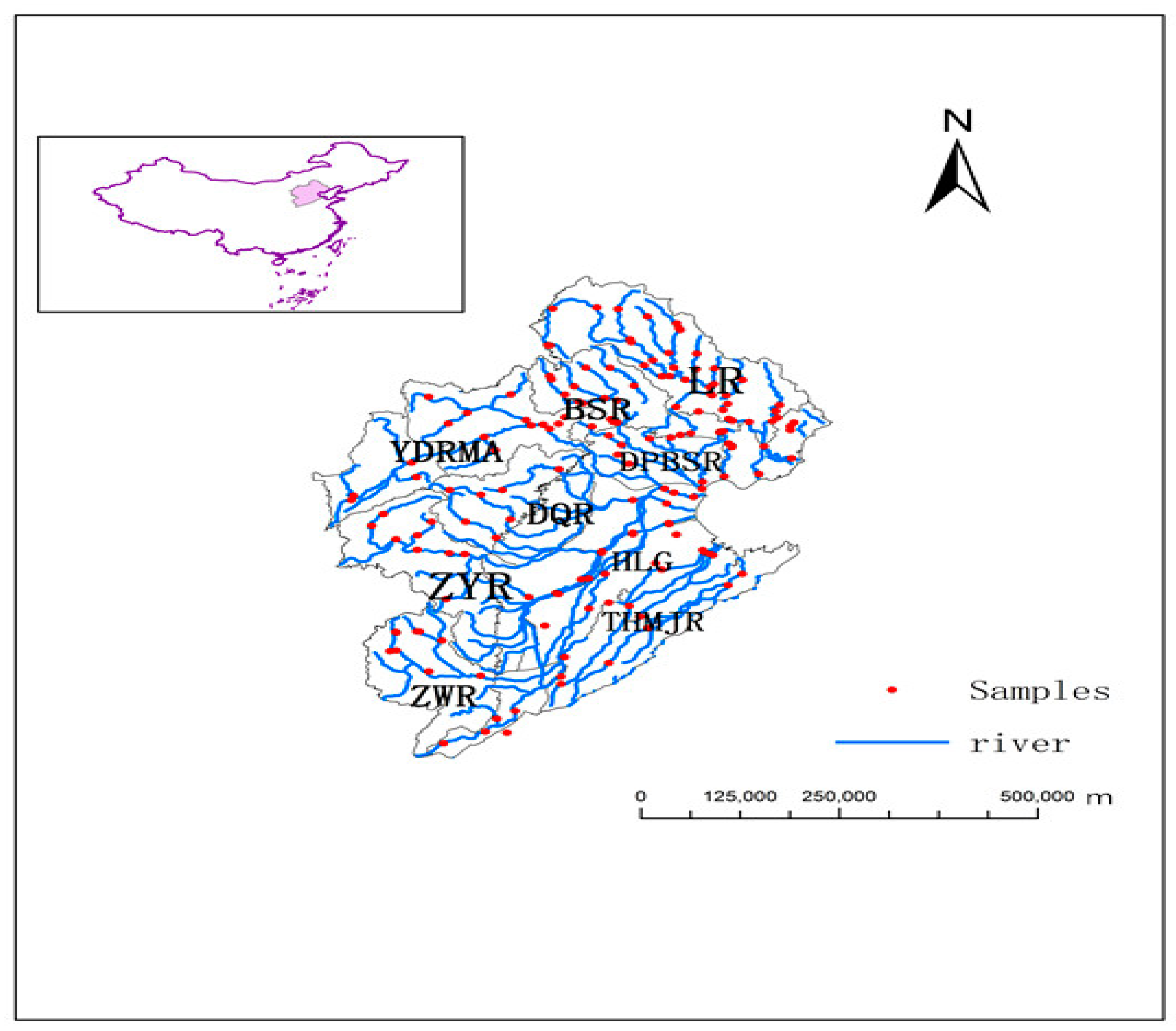
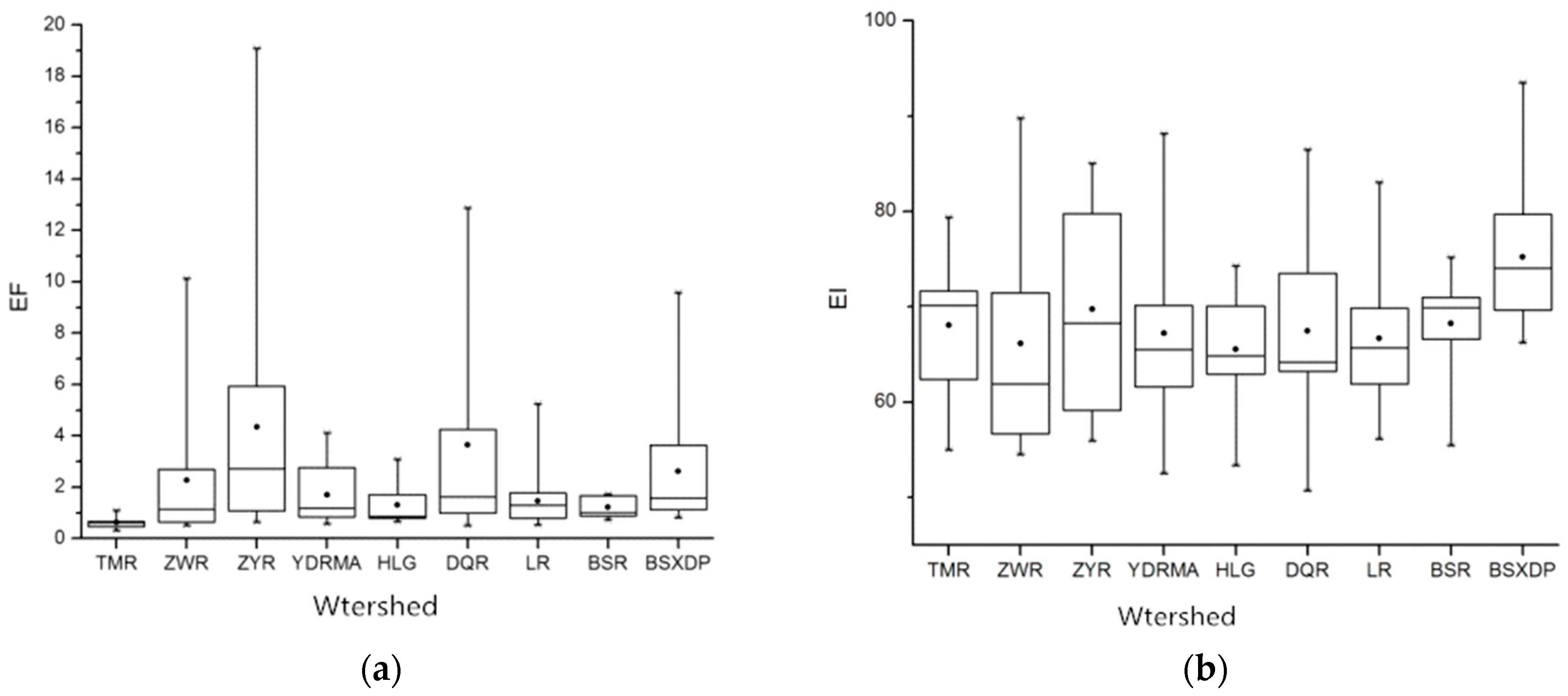
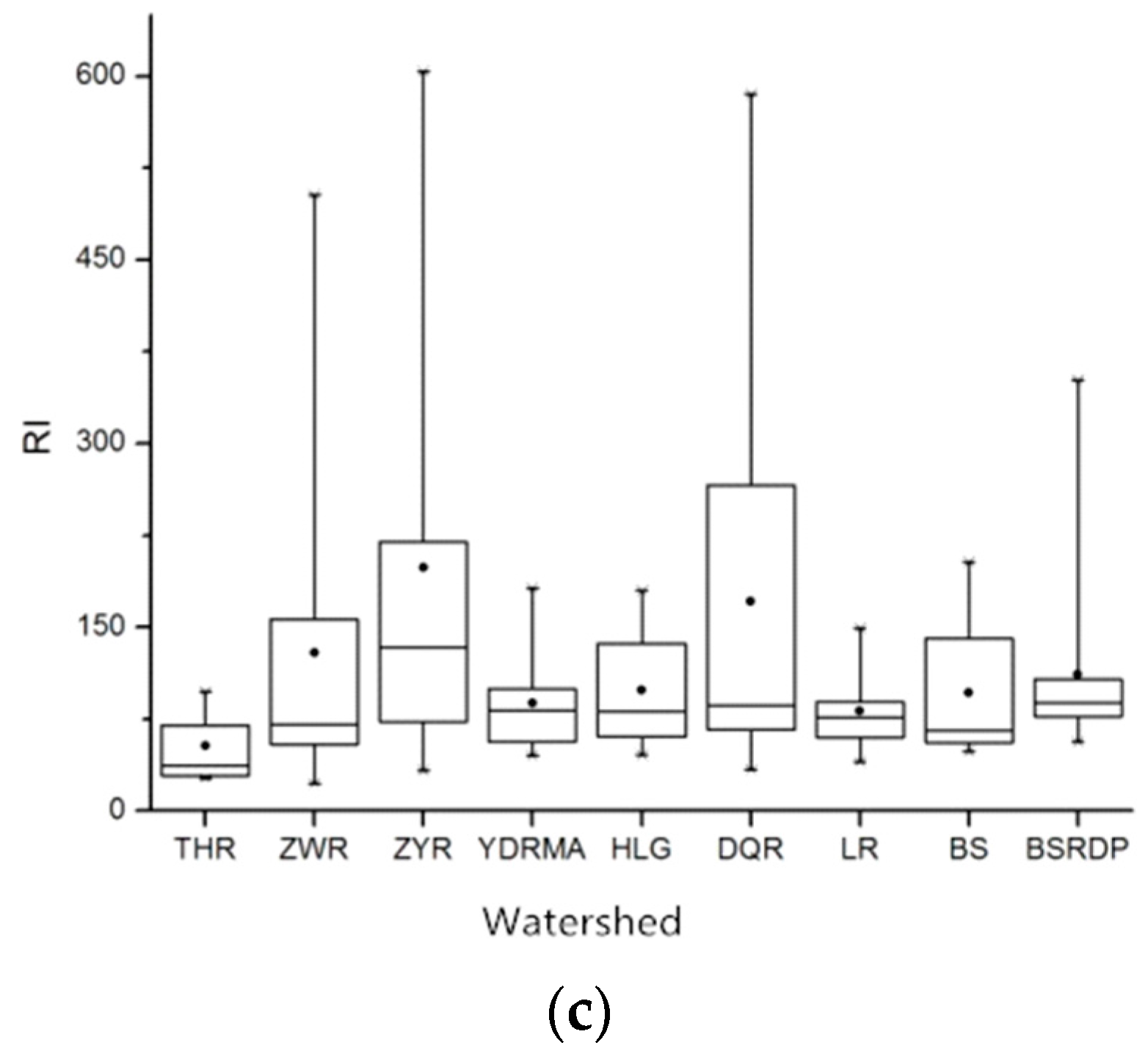
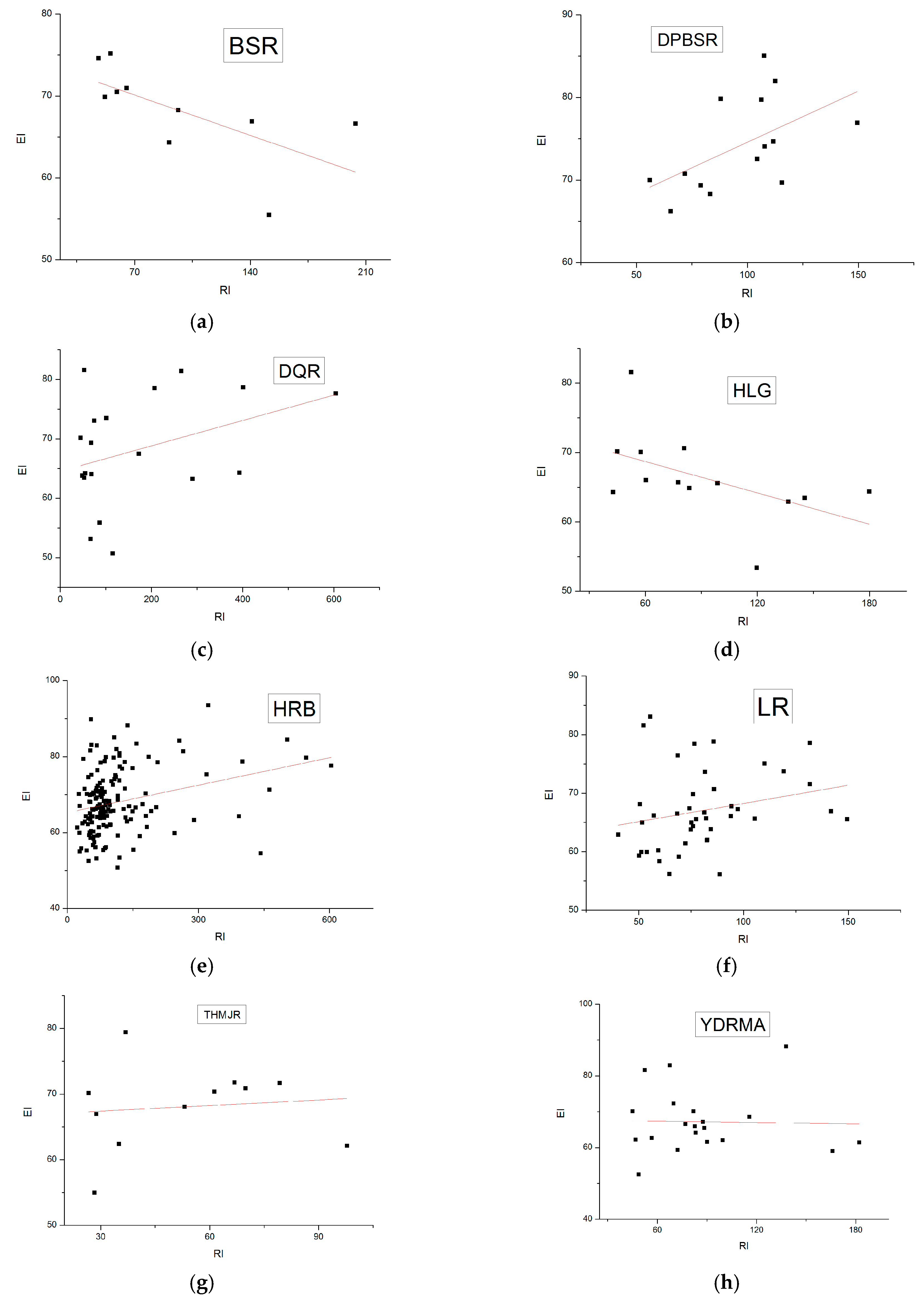
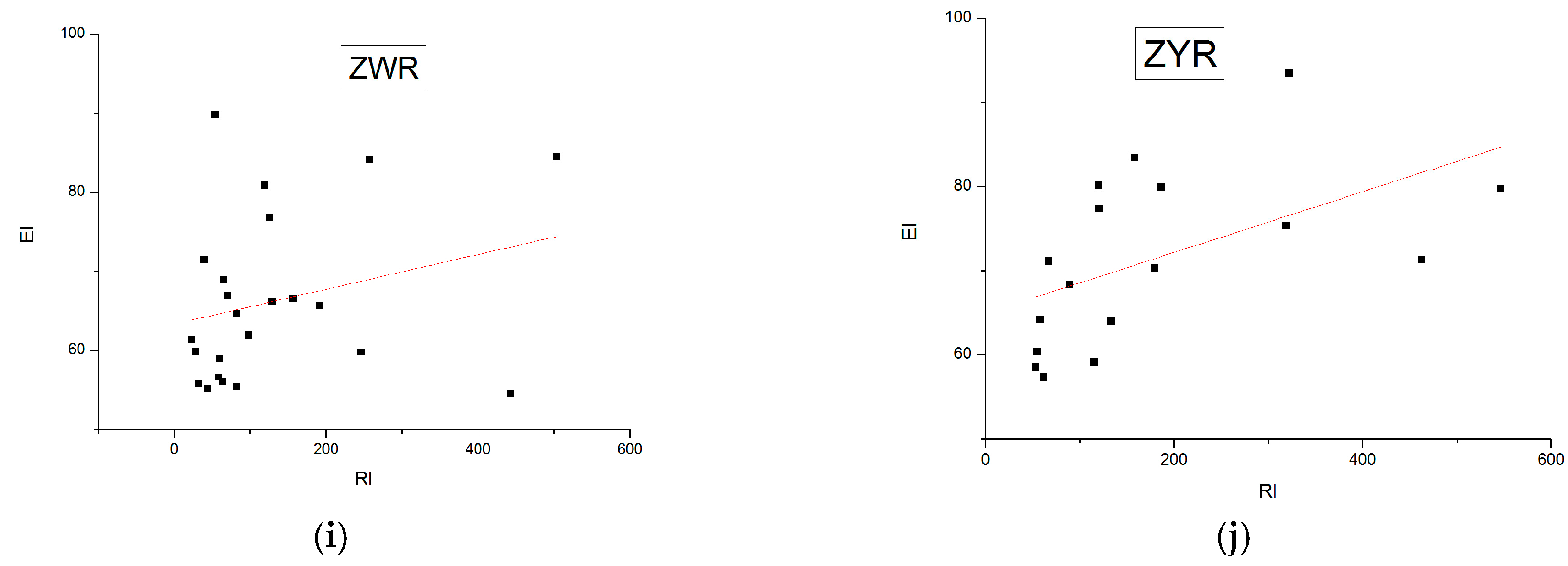

| Sub-Watershed | Population | Area (km2) | GDP (10,000 RMB) | Primary Industry | Secondary Industry | Tertiary Industry |
|---|---|---|---|---|---|---|
| TMR | 18,510,849 | 31,791 | 71,021,404 | 7,243,197 | 42,719,075 | 20,781,532 |
| LR | 7,804,268 | 54,714 | 42,525,138 | 5,921,784 | 22,001,459 | 14,606,857 |
| BSR | 2,876,720 | 22,837 | 10,549,533 | 1,085,942 | 5,701,739 | 3,762,852 |
| DPBSR | 22,869,859 | 15,526 | 182,803,065 | 8,309,523 | 60,153,210 | 114,644,832 |
| YDRMA | 8,174,667 | 45,110 | 24,551,780 | 3,074,289 | 11,205,801 | 10,315,630 |
| HLG | 13,973,100 | 22,623 | 31,798,491 | 5,539,002 | 15,609,087 | 8,650,504 |
| ZYR | 22,222,428 | 45,961 | 118,990,777 | 15,780,793 | 63,784,257 | 40,233,729 |
| DQR | 31,539,879 | 44,930 | 149,004,884 | 8,851,276 | 76,784,508 | 62,987,377 |
| ZWR | 7,419,872 | 35,126 | 17,033,732 | 1,600,767 | 10,106,470 | 5,326,496 |
| Polluant | I | II | III | VI | V | Haihe |
|---|---|---|---|---|---|---|
| TN | 0.2 | 0.5 | 1 | 1.5 | 2 | 5.05 |
| TP | 0.02 | 0.01 | 0.2 | 0.30 | 0.4 | 0.98 |
| NH3-N | 0.15 | 0.5 | 1 | 1.5 | 2 | 0.45 |
| NO3-N | 2 | 5 | 10 | 20 | 20 | 3.56 |
| COD | 15 | 15 | 20 | 30 | 40 | 37.87 |
| Cu | Zn | Cr | Pb | Ni | Cd | As | |
|---|---|---|---|---|---|---|---|
| Concentration (mg/kg) | 51.01 | 167.27 | 112.09 | 37.81 | 41.38 | 0.20 | 7.56 |
| Background value (mg/kg) | 20.00 | 67.7 | 53.9 | 26.0 | 26.9 | 0.074 | 9.21 |
| PER | 10.57 | 2.34 | 3.26 | 8.79 | 7.00 | 68.71 | 10.81 |
| EF | 2.35 | 3.38 | 1.10 | 2.50 | 1.05 | 3.71 | 1.02 |
| NH3-N | NO3-N | TN | TP | COD | Cu | Zn | Cr | Pb | Ni | Cd | As | |
|---|---|---|---|---|---|---|---|---|---|---|---|---|
| NH3-N | 1 | |||||||||||
| NO3-N | 0.046 | 1 | ||||||||||
| TN | 0.611 ** | 0.605 ** | 1 | |||||||||
| TP | 0.067 | 0.035 | −0.012 | 1 | ||||||||
| COD | 0.286 ** | −0.081 | 0.167 * | 0.169 * | 1 | |||||||
| Cu | 0.212 ** | 0.375 ** | 0.374 ** | 0.150 | 0.190 * | 1 | ||||||
| Zn | 0.355 ** | 0.101 | 0.267 ** | 0.091 | 0.255 ** | 0.581 ** | 1 | |||||
| Cr | 0.135 | 0.065 | 0.158 * | 0.125 | 0.198 * | 0.223 ** | 0.617 ** | 1 | ||||
| Pb | 0.149 | 0.130 | 0.130 | −0.106 | 0.069 | 0.248 ** | 0.537 ** | 0.195 * | 1 | |||
| Ni | 0.288 ** | 0.194 * | 0.328 ** | 0.154 | 0.205 ** | 0.686 ** | 0.809 ** | 0.673 ** | 0.245 ** | 1 | ||
| Cd | 0.090 | 0.071 | 0.089 | −0.002 | 0.118 | 0.241 ** | 0.511 ** | 0.375 ** | 0.468 ** | 0.364 ** | 1 | |
| As | −0.065 | −0.094 | −0.148 | 0.128 | −0.170 * | −0.019 | 0.002 | −0.005 | 0.164 * | −0.017 | 0.183 * | 1 |
| TMR | ZWR | ZYR | YDRMA | HLG | DQR | LR | BSR | BSRDP | HRB | |
|---|---|---|---|---|---|---|---|---|---|---|
| r | 0.104 | 0.264 | 0.627 ** | 0.379 | −0.027 | 0.992 ** | 0.235 * | −0.654 | 0.631 ** | 0.318 * |
| R2 | 0.01 | 0.069 | 0.393 | 0.143 | 0.001 | 0.984 | 0.055 | 0.428 | 0.398 | 0.101 |
| Population | GDP | Primary Industry | Secondary Industry | Tertiary Industry | |
|---|---|---|---|---|---|
| r | 0.789 ** | 0.749 ** | 0.625 | 0.781 ** | 0.642 |
| R2 | 0.625 | 0.559 | 0.388 | 0.608 | 0.412 |
© 2018 by the authors. Licensee MDPI, Basel, Switzerland. This article is an open access article distributed under the terms and conditions of the Creative Commons Attribution (CC BY) license (http://creativecommons.org/licenses/by/4.0/).
Share and Cite
Kong, P.; Cheng, X.; Sun, R.; Chen, L. The Synergic Characteristics of Surface Water Pollution and Sediment Pollution with Heavy Metals in the Haihe River Basin, Northern China. Water 2018, 10, 73. https://doi.org/10.3390/w10010073
Kong P, Cheng X, Sun R, Chen L. The Synergic Characteristics of Surface Water Pollution and Sediment Pollution with Heavy Metals in the Haihe River Basin, Northern China. Water. 2018; 10(1):73. https://doi.org/10.3390/w10010073
Chicago/Turabian StyleKong, Peiru, Xian Cheng, Ranhao Sun, and Liding Chen. 2018. "The Synergic Characteristics of Surface Water Pollution and Sediment Pollution with Heavy Metals in the Haihe River Basin, Northern China" Water 10, no. 1: 73. https://doi.org/10.3390/w10010073




